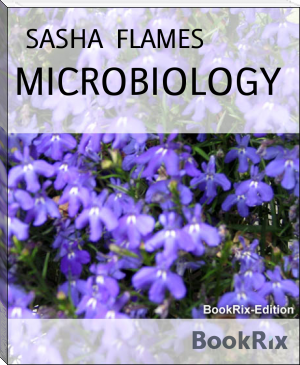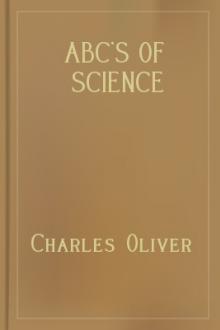MICROBIOLOGY by SASHA FLAMES (the rosie project .TXT) 📕

Read free book «MICROBIOLOGY by SASHA FLAMES (the rosie project .TXT) 📕» - read online or download for free at americanlibrarybooks.com
- Author: SASHA FLAMES
Read book online «MICROBIOLOGY by SASHA FLAMES (the rosie project .TXT) 📕». Author - SASHA FLAMES
THE SCOPE OF MICROBIOLOGY
Microbiology is the study of microscopic organisms.It derives its'name from the Greek words-mikros (small)bios (life) and logos (study).Microbiology are organisms which are tiny and invisible to the naked eye. Since the microbes are living,it follows that microbiology deals with a group of particuar life forms and it comes under the broad domain of biology which includes the study of all aspects of living beind includind man.
where can we fix in microbes in the hierarchy of living beings? Traditionaly, living being are divided into plants and animals.But members of the microbes can be accommodated in both plants[fungi] and animals[protozoa] and some cannot be accommodated in either plants or animals e.g Euglena as they share the character of both plants and animal. In one of the earlier attempt to resolve this problems, HAECKEL[1866] a German zoologist, suggested that there should be a third kingdow besides Plantae and Animalia to include all the microorganisms[protista]
Hackel's classification revised some questions like how to distinugish a fungus from a bacterium or from an alga. The discovery of Prokaryotic and Eukaryotic nature of cells in 1940s rendered the three kingdow classification unsatisfactory. A recent and comprehensive classification by R.H Whitttaker[1969] has five kingdow of living beings:
Kingdow Monera Kingdow Protista Kingdow Fungi Kingdow Animalia Kingdow PlantaeMicrobiology includes the three [ Monera,Protista and Fungi]. At present, it is agreed that within the preview of microbiology,five major groups of microorganisms-viruses,bacteria,fungi,algae and protozoa are dealt within.
As it is evident from the above discussion,the scope of microbilogy extends to both Eukaryotic as well as Prokaryotic microbes. While dicussing the scope of microbiology,it should be evident to us that it does not deal with the merely the enumeration of diversity or classification but extends to all aspects of microbial life. Microbiology is concerned with the form,sturcture,reproduction,physiology,metabolism,classification and modt importance their economic imprtance importance.
CHAPTER TWO-THE NAMES OF SCIENTISTS THAT DEVELOP MICROSCOPE AND MICROBIOLOGY.THE SCIENTISTS THAT ARE INVOLVED IN THE DEVELOPMENT OF MICROSCOPE AND MICROBIOLOGY
The science of microbiology started with the invention of the microscope.
The English scientist ROBERT HOOKE is credited with being the first person to use the microscope for acedemic study that was in the early 1660s. In 1665, HOOKE published a landmark book MICROGRAPHIA, which described the microscope world for the first time. He studied plant section in particular cork and he draw what he saw, which was a tiny matinx of cylinderal sturcture he called CELL. Todaybit is condered to be a foundation stone in all understanding of microbiology. ANTONIC VAN LEEUWENHOEK[1632-1723], In the Netherland were using microscope to look at animal and plant tissue. He examined a drop of rainwater and noticed it contained tiny creatures he called 'ANIMALICULES' or littlr eels. He became the first person to study bacteria. EDWARD JENNER[1749-1823] who in 1796 injected COWHAND JAMES PHIL with cowpox. Jenner got credit because he carried out his work using accepted scientific method and wrote it up afterwards,though the ethnic of deliberately injecting experimental subject with small pox some week later is questionable but fortunately,the boy did not develop smallpox and he became rich and famous as a result. it was from this risky beginning that the science of immunization developed. FERDINAND .J. COHN who in 1875 effictively founde the science of bacteriology[a branch of microbiology which studies bacteria]. His main contribution was the classification of bacteria and he coined the term BACILLUS LIOUS PASTEUR who probably the greatest biologist of the 9th century. He developed the germ theory of disease which was a significant breakthrough in medicine. That utimately improved the health of everyone on the planet. He was also able to prove that life itseif did not spontaneousy come into being through series of experiment using a sterilized flask. He successfully showed that life can only be generated from existing life thus closing debate. Pasteur also showed that FERMENTATION- is a process used in baking and brewing was caused by micro-organisms. As a result of this work, he went to develop the process of sterilizing milk and this was named after him"PASTEURIZATION. He also credted with the development of vaccines most notably for rabies and anthrax. He identified and eliminated disease in silkworms. He was also interested in the idea of panspermia that was promoted by LORD KELVIN in 1871. FRACASTORO[1478-1553] gave syphilis its name in the 6th century and core close to devising a germ theory of disease, an idea that later attracted a number of workers all the way down to the 9th century.SCHWANN and CAGNIARD-LATOUR show that ALCOHOLIC FERMENTATION and putrefraction were due to living organised beings. If one accept the fact that the decomposition of organic materials was due to living organisms. JACOB HENLE in 1840 further commented on the similiarty and with the new found knowledge on the nature of fermentation, he proceed clear conclusion. ROBERT KOCH provided in 1867 the final evidence providing the germ theory. He establish the etiologic role of bacteria in anthrax and as result proposed a set of rules to be followed in the establishment of etiology. PAUL ENHRLICH[1854-1915] it is possible to cure a person suffering from disease by injecting some antiotoxin serum perpared by earlier immunization of a horse or other large animal. This lead to rational cures for infections diseases and was responsible for ENHRLICH's later conception of chemotherapy. ALEXANDER FLEMING[1881-1955] he also found about penicillin which was another important step in the understanding of microbiology. OSWALD AVERY,COLLINS MACLEOD AND MADYH MACANTY. They demonstrated that the transforming principle in bacteria previously observed by FREDRICK GROFFITS in 1928 was DNA. CHAPTER THREE-THE ROLES OF MICROBIOLOGY
THE ROLES OF MICROBIOLOGY
NURSING: Use of microbiology in nursing is concerned with diagnosis. it helps to see how the patient's health is progresses during the treatment. it gives the knowledge to nurse on how to handle a patient and his sample infected with communicable disease. nurses can also identify blood group of the patient by simple immue reactions. it also helps to detect diseases like tuberculosis by simple skin test namely the mantoux test. Diagnostic tests like Elisa electrophoreis and randiommie assay use principle of microbiologyfor identification of disease. PHARMACY: Pharmacy and pharmaceutical companies uses microbiology extensively. it is used for :For production of medicines like antibiotics,enzymes,vaccines insulin,vitamins,steroids etc.some of the substances are exclusively obtained by microbial cultures. For sterilization of manufacturred drugs microbes are destoryed by sterilization. Also many new drugs are in search by use of microbiology. since many antibiotics enzymes etc were derived from microbes,still the microbes are searched for more new drugs. MEDICAL MICROBIOLOGY: In medical microbiology,is taught for the people to understandtheTypes of microbial diseases ie how diseases are caused by microbes.Their types like bacteria,virus,fungi etc. Dignosis and treatment even the diagnosis of the disease causing microbes is taught so as to give the right drug and combat infection effectively. The identification of specific microbes is done by help of microbiological. AGRICUILTURE: Natural pesticides- few microbes like bacteria and virus are expoilted against pest attacking farm crop hence they are called natural pesticides. Natural manure- few microbes lie algae and bacteria are grown up to enhance the soil ferility by fixing nitrogen and also water retaining capacity of soil. They maintain soil microbiology suitable for plant growth. Decompose the waste- microbes decompose synthetic pesticide residue and other toxin material in the agriculture soil and thereby protecting tarm from toxin accumulation.
CHAPTER FOUR-THE PRINCPLES,TYPES AND APPLICATION OF MICROSCOPE.
THE PRINCIPLES OF THE MICOSCOPES,TYPES AND APPLICATION.
Aplication of the microscope is and the techniques used in historical study and study of microbiology. The microscope is used to determine the morphology or morphological characteristies of micro-organisms such as bacteria, fungi,protozoa,alga and viruses. Morphology can be obtained by using a simple lens e.g hand lens or a microscope. This is because the human eye cannot discern any detail of the object smaller than 0.1mm although smaller object can be seen when they are placed against a contrusting background. There are several types of microscope available for this purpose and many techinques too have been developed by which specimen containing micro-organisms cabn be prepared for examination under the microscope.
THE TYPES OF MICROSCOPE
There are two kinds of microscope-light and electron, while the types of microscope are:





Comments (0)